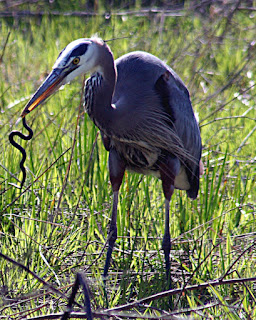 |
| Wrestling copperhead and king snake - Photo by BH's grandpa |
One of the students in the new WOLF School Class (BH) shared these photographs of a copperhead and a speckled king snake in a fatal embrace. I asked her grandpa to share the story with me.
"When I came upon the snakes they were already entangled, I took a
few pictures. When the copperhead's head was exposed I hit it on the
head, it seemed to relax. The king snake then started attacking the
copperhead's head. I had to leave and when I came back there were no
signs of either snake. I assume the king snake ate the copperhead."
First I want to address the copperhead. Regular readers know that we protect snakes and never harm them
unless they are a clear threat to humans. We have had to kill a rattlesnake on our deck and copperheads in the front yard of the cabin on August nights. Occasionally I can
transplant them with the proper equipment -
do not try this at home! On the other hand we see venomous snakes out in our fields and
roads commonly and we respect each other and would never harm them when they are in their territory. This below from the MDC website sums this up well.
Missouri's Wildlife Code Protects Snakes
Few Missourians realize that all snakes native to our state are
protected. The Wildlife Code of Missouri treats snakes, lizards, and
most turtles as nongame. This means that there is no open season on
these animals, and it is technically unlawful to kill them. There is a
realistic exception, however: when a venomous snake is in close
association with people, which could result in someone being bitten. We
hope that more people realize that snakes are interesting, valuable,
and, for the most part, harmless. Snake Facts Overview
The copperhead's encounter with the king snake likely would not have ended well even without human intervention. The
speckled king snake is known to be immune to the venom of other snakes and even eats rattlesnakes, although it is not necessarily immune to the venom of snakes from different localities.
Wikipedia
As he describes, the king snake tackled the problem head on, the only way to swallow a snake.
 |
| "Down the hatch!" - Photo by BH's grandpa |
Your new word of the day is
"opiophagous," Greek for "snake eating." Unlike the old adage of eating an elephant a bite at a time, animals without a knife and fork require special techniques. Like the heron here, head-first is the recommended method for opiophagous (OP) critters lacking teeth like king snakes. Other common OPs include skunks, collared lizards, hawks, and the famous mongoose. The
Virginia opossum (
Didelphis virginiana)
has been found to have the most resistance towards snake venom, an immunity that is not acquired and has probably evolved as an adaptation to
predation by venomous snakes in their habitat.
 |
| Died of a pellet in the head- 2011 |
We have a strict rule at Bull Mills -
never harm any snake unless it is a threat to you or others. The last rattlesnake we had to kill at the house was in 2011 although we see one several times a year on the road or the glade. On those occasions we remind them that we are too big to eat and if it wastes it venom it won't be able to eat for several days. They simply shake their tail and crawl away.



